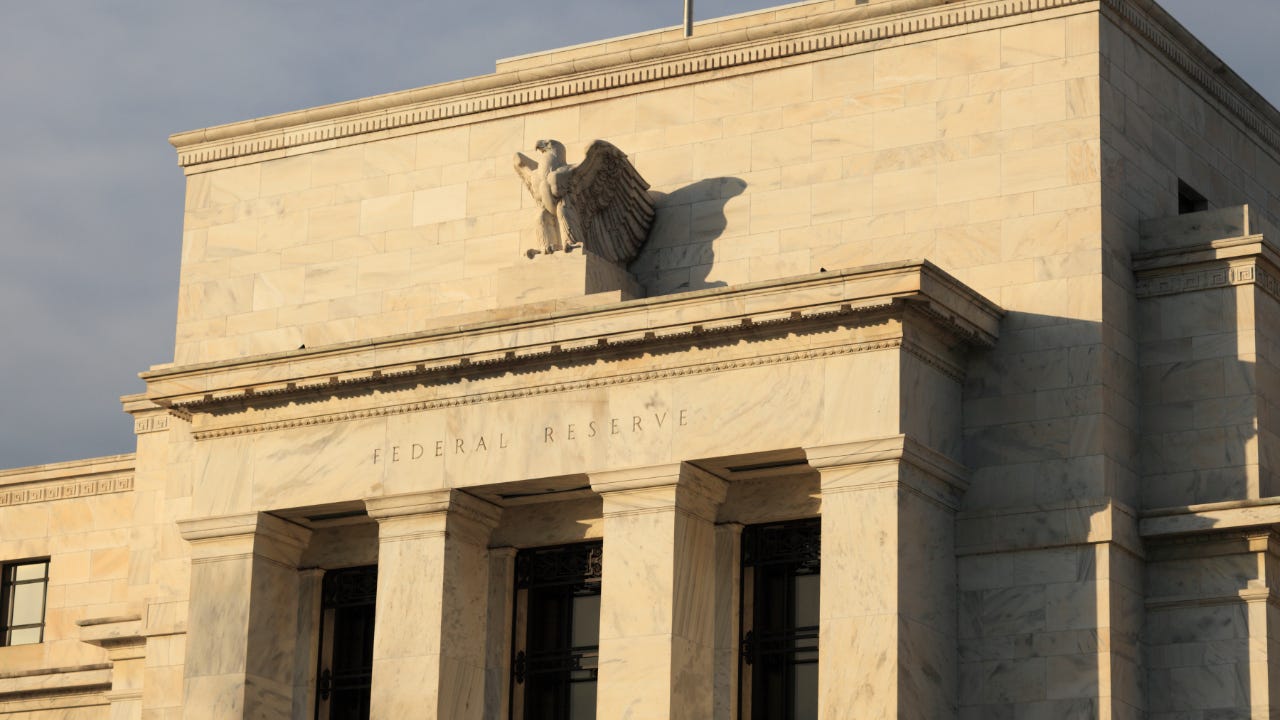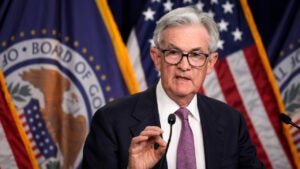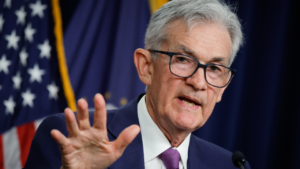If the Fed cuts interest rates, expect it to be an ‘insurance’ cut — here’s what that means

What’s all this talk about a Federal Reserve rate cut?
The unemployment rate hasn’t been this low since Neil Armstrong walked on the moon. Inflation shows no signs of spiraling out of control. It looks like these conditions would speak positively toward the Fed’s goals — but it’s also why officials are worrying.
A number of uncertainties are threatening the longest U.S. economic expansion on record, from trade wars and slowing global growth, to weakness in manufacturing and business investment. All the while, interest rates are near historic lows, and inflation has remained stubbornly below the U.S. central bank’s 2 percent target, making it harder for Fed officials to react to a slowdown.
The Fed signaled that they think it’s time to cut interest rates for the first time since 2008, and it’s looking increasingly like it will occur at the U.S. central bank’s next meeting on July 30-31.
But since the adjustment looks poised to happen before any broad-based slowdown occurs, it’s going to be unlike most others: an “insurance” cut.
“The trajectory of growth is really turning a corner, and the Fed is trying to be proactive,” says Michael Reynolds, investment strategy officer at Glenmede. “The way we view an insurance rate cut is, it’s a proactive move to protect against what seems to be potential but unpredictable risks.”
Here’s everything you need to know about this unique type of easing from the Fed, and what it means for your money.
What’s an ‘insurance’ rate cut?
Believe it or not, this form of monetary policy is likely similar to steps you take in your financial life. Say you just purchased a new car. You wouldn’t want all of that hard-earned money to go to waste if an unexpected emergency happened. In response, you get insurance to help you out against any significant financial loss or liability.
That’s essentially what Fed officials are doing. By cutting rates prematurely, they’re taking out an insurance policy on the U.S. economy. They’re hoping the cut can act as a positive stimulus and prevent a slowdown, in case trade negotiations go south or in case the global growth weakness manifests itself deeper in the U.S.
“It’s very important that this expansion continue as long as possible,” Powell told members of the Senate Banking Committee during his semiannual testimony to Congress on July 11. “The U.S. economy is in a very good place, and we want to use our tools to keep it there.”
“Usually, there are two types of rate cuts,” says Zhiwei Ren, managing director and portfolio manager at Penn Mutual Asset Management. “There’s the typical rate cut in the recession. Those rate cuts happen when the economy slows down significantly; they’re rate cuts to save the economy.
“And the other type of rate cut is the insurance cut,” he added. “The economy is doing fine, the Fed sees no risk of inflation, so they can cut rates to further support the economy’s growth.”
How is it different from other types of easing?
The broader context of the U.S. economy’s performance is the main way that an “insurance cut” differs from other types of Fed easing. But these cuts are also different because of their size and scope.
As the Fed indicated in its dot plot, officials are not expecting to lower interest rates by more than half of a percentage point over the next two years. The first time the Fed embarked on an easing cycle, which was during the aftermath of the financial crisis, the Fed slashed rates to near-zero from their high of 5.25 percent.
An insurance rate cut of between 25 and 50 basis points is a “modest” Fed move, says Greg McBride, Bankrate’s chief financial analyst.
“Leading up to and during the financial crisis, the economy was in real trouble,” McBride says. “Fed rate cuts were chasing the weakness in the economy that was already being seen. The economy now is in decent shape.”
It wouldn’t, however, be the first time the Fed has cut rates preemptively. In 1995 and 1998, the Fed took out insurance by enacting cuts, hoping to act against a potential weakening of the economy — though they didn’t see a near-term recession on the horizon.
In 1995, the Fed made three rate cuts because of moderating inflation. Three years later, in 1998, the near-collapse of hedge fund Long Term Capital Management threatened the financial system, as did turmoil associated with Russia’s debt default. The Fed, as a result, chose to make three more cuts.
“It was like putting up hurricane shutters because you knew a storm was coming,” McBride says. “It was entirely defensible, and it worked.”
How might an insurance rate cut impact the economy?
Most experts are aligned on the idea that a modest rate cut won’t alter the economy significantly. The Fed has hiked rates nine times since 2015, four of them occurring just last year. A 25 or 50 basis point cut would simply unwind one or two of those.
Still, when the Fed enacts any kind of rate cut, it makes money cheaper to borrow, McBride says. That’s going to happen regardless of how substantial the cut is.
A modest rate cut “would be tough to notice, but nonetheless, the prospect of lower rates means essentially a lower cost of money,” McBride says. “When money is cheaper, it becomes more enticing to borrow and that borrowing can be done by governments, municipalities, companies and consumers. The more borrowing that takes place, the more potential there is for economic growth. That money gets cycled back into the economy.”
But sometimes making money cheaper doesn’t always do the trick. It could be a question of demand, and if businesses and consumers don’t want to spend, they may not, despite the fact that a rate cut occurred.
“Rates are pretty low to begin with,” says Scott Clemons, chief investment strategist at Brown Brothers Harriman. “The effective fed funds rate at which transactions actually take place is right now at 2.4 percent. … I cannot think of a single business that thrives at a 2.15 percent interest rate environment and dies at 2.4 percent. The impact is just immaterial.”
Most of the impact so far has been in restoring investors’ confidence and sentiment. That’s exactly what’s happened since the Fed signaled a rate cut could be coming.
After Powell delivered exceptionally dovish remarks during his semiannually testimony to Congress and refused to push back against the markets’ unanimous expectations that the Fed will cut rates in July, the S&P 500 briefly topped an all-time high of 3,000 for the first time. The Dow then reached 27,000 and has been flirting with additional record highs.
For that reason, signaling the rate cut might be just as powerful — if not more — than the rate cut itself, Reynolds says.
“The Fed has gotten really good at being very transparent as to where they’re considering their next moves,” he says. “Their major rate changes over the past couple of years, none of them have been very surprising. They’ve been well-telegraphed. It gives the U.S. economy a bit of time to react ahead of time, to get your ducks in a line.”
One question that remains, however, is how an “insurance” rate cut could impact the bond market. Typically, when interest rates fall, bond yields rise. That’s because investors selling their bonds on the open market can then sell them at a higher rate compared to what they originally purchased them at. In other words, the interest rate on a bond would be considered more valuable because it would be paying a coupon rate higher than what’s now on the market.
But with an insurance cut, that’s not a guarantee. Bond values also fluctuate depending on general market and economic conditions. Investors might not necessarily be willing to pay a higher premium for those bonds, Ren says.
“The economy is doing fine. There’s no risk of a recession, so when they cut rates, it means the economy will go even further and faster, and inflation will go even higher,” Ren says. “Usually, if you have higher growth and higher inflation, the long-term bond yields will go higher.”
What are the risks?
But an insurance rate cut does come with its own set of risks. Interest rates are already near historic lows, and typically, the Fed uses an average of 500 basis points to aid an ailing economy during a downturn. With interest rates only at a range of 2.25 percent and 2.5 percent, that would barely get the Fed up to 250 basis points, if officials saw it necessary to slash rates back down to the zero-lower bound.
If the Fed uses up its remaining ammunition now, there’s a chance that fighting off the next recession could be even harder.
“There’s only so much room to cut interest rates,” McBride says. “If they start using that up now, it leaves them with less to work with when the economy really does need lower rates. It wouldn’t even have to be a very severe economic downturn before we would get to that point” of reaching the zero-lower bound.
Fed officials may also face criticism, if they do indeed decide to enact an insurance rate cut, that they’re bending to pressure. President Donald Trump hasn’t been shy about expressing his disapproval of Fed policy, blasting officials for not cutting rates sooner.
Meanwhile, the markets have priced in a rate cut so heavily that the Fed may be “backed into a corner,” Ren says.
“If everyone in the markets think the Fed is going to cut rates in the next month, and the Fed says it’s not going to cut rates, it would be a huge disappointment for the markets,” Ren says. “You would have a huge shock. If everyone is positioned for a rate cut, the Fed doesn’t want to see a bear market.”
But it’s debatable as to whether there’s a significant enough of a threat from the downside risks to the economy, says Aaron Anderson, senior vice president of research at Fisher Investments.
“We’ve got an environment where the economy is doing just fine,” Anderson says. “Inflation is low. They don’t need to be hiking rates necessarily, but there’s no need to be cutting rates either.”
There’s also the risk that the Fed could potentially fuel some asset bubbles that could pose a threat to the U.S. economic expansion. The last two recessions were caused by financial imbalances that burst. Stock prices have cheered the message of a Fed rate cut, and there’s also the chance they could push even higher after it happens. But “eventually, assets will be priced according to the fundamentals,” McBride says. “If cutting interest rates pushes stock prices even higher to the point where valuations are out of line, a day of reckoning is inevitable.”
When the question comes up in public, Powell says it’s better to act “preemptively” in the event of a downturn, rather than be too late to the game.
“It’s the idea that an ounce of prevention is worth a pound of cure,” McBride says. “Let’s do one rate cut now, so we don’t have to do three or more later.”
What does this mean for your money?
You probably feel like you’re facing some conflicting signals. A downturn doesn’t look inevitable, but the Fed looks like it’s teeing up a rate cut — an action typically reserved for recessions.
But even though a downturn isn’t expected to arrive in the near future, it’s still prudent to take the steps to prepare now.
That means paying off high-cost debt and boosting your emergency savings, McBride says. Create some financial breathing room in your budget now, and it should pay off by the time the U.S. economy actually reaches a downturn.
“It’s the financial equivalent of fastening your seatbelt and looking both ways before crossing the street,” McBride says. “The labor market is the strongest it’s been in 50 years. There are more open jobs than unemployed people. It’s comparatively easy to get work or get more work through contracts or side hustles, even on a temporary basis, to get something like your credit card debt paid off once and for all, or to stash some money into a savings account, so that you have a buffer whenever it’s needed.”
Learn more:
- 5 ways the Fed’s decisions on interest rates impact you
- With the Fed poised to cut rates, keep an eye on your APY
- Compare savings accounts and rates
Why we ask for feedback Your feedback helps us improve our content and services. It takes less than a minute to complete.
Your responses are anonymous and will only be used for improving our website.






